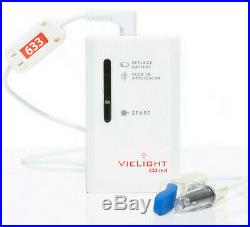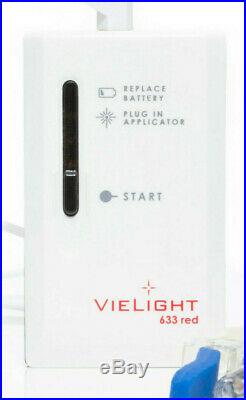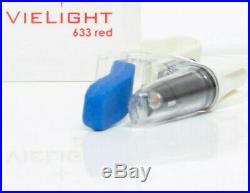



VIELIGHT Red Systemic Personal Photobiomodulation Intranasal Light Therapy NEW. The Vielight 633 Red is a compact personal photobiomodulation (PBM) device. Its cold LED 633nm red beam is ideal for systemic photobiomodulation via photonic diffusion through the nasal blood capillaries. The Vielight 633 Red and Vielight 655 Prime are comparable in efficacy. May assist with inflammation and many conditions – please read detailed information below. Mechanisms of Brain Photobiomodulation. Brain photobiomodulation (PBM) utilizes red to near-infrared (NIR) photons to stimulate the cytochrome c oxidase enzyme (chromophore/complex IV) of the mitochondrial respiratory chain because this enzyme is receptive to light energy. Outcomes are an increase in ATP synthesis, leading to the generation of more cellular energy. Additionally, photon absorption by ion channels results in release of Ca. Which leads to the activation of transcription factors and gene expression. There are several mechanisms associated with promoting physiological change through photobiomodulation therapy (PBMT). The wavelengths primarily used with PBM is within the near-infrared range of the electromagnetic spectrum with a sufficient power density. When hypoxic/impaired cells are irradiated with low level NIR photons, there is increased mitochondrial adenosine tri-phosphate (ATP) production within their mitochondria. Another change is the release of nitric oxide from the hypoxic/impaired cells. Neurons are cells that contain mitochondria and nitric oxide. In hypoxic neuronal cells, cytochrome-C oxidase (CCO), a membrane-bound protein that serves as the end-point electron acceptor in the cell respiration electron transport chain, becomes inhibited by non-covalent binding of nitric oxide. When exposed to NIR photons, the CCO releases nitric oxide, which then diffuses outs of the cell increasing local blood flow and vasodilation. Following initial exposure to the NIR photons, there is a brief burst of reactive oxygen species (ROS) in the neuron cell, and this activates a number of signaling pathways. The ROS leads to activation of redox-sensitive genes, and related transcription factors including NF. The PBMT stimulates gene expression for cellular proliferation, migration, and the production of anti-inflammatory cytokines and growth factors. The nasal cavity is rich with blood capillaries. There are more capillaries per cm. Than in most organs of the body. Five arteries connect to the nasal cavity, while the Littles area is a frequent site of nasal bleeding. Given the rich supply of blood and the thin, permeable membrane within the nasal cavity, the light can easily reach the blood. Thus, this area is well-suited for systemic photbiomodulation which via blood. The item “Red Light Therapy. Intranasal Photobiomodulation. Vielight Brain Inflammation” is in sale since Thursday, November 21, 2019. This item is in the category “Health & Beauty\Natural & Alternative Remedies\Light Therapy Devices”. The seller is “thra_13″ and is located in Colonel Light Gardens, SA. This item can be shipped worldwide.
- Brand: Vielight
- Custom Bundle: No
- Modified Item: No
- Type: Infrared
- Bundle Description: Does Not Apply